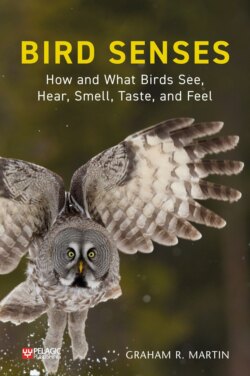Читать книгу Bird Senses - Graham R. Martin - Страница 26
На сайте Литреса книга снята с продажи.
Trade-offs within a sense
ОглавлениеWhen attempting to understand the behaviour of particular species the above examples of complementarity or trade-offs between the information received from different sensory systems are particularly important and fascinating. However, significant trade-offs also occur within a sensory system. In fact, compromises and trade-offs within a sense should be considered the norm. This reflects the simple truth that within a particular sensory system it is not possible to collect all of the information that is potentially available.
Trade-off within a sense is clearly seen in the relationship between visual resolution and sensitivity. At the very limit, both resolution and sensitivity are determined by the quantal nature of light and by noise within the nervous system. This trade-off is evident most dramatically in the fact that resolution always decreases as higher sensitivity is gained. We experience this every day of our lives: as light levels naturally fall, and our eyes become more sensitive to dim light, we accept that there is less detail in a scene. But the detail has not gone away, it is still there, it is just not detected by our eyes, which are adapted to detect the reducing number of light quanta in the environment.
Our loss of spatial details with decreasing light levels is not just a quirk of our vision. It is because it is a fundamental constraint on any vision system, including cameras. It is the very physical nature of light, its quantal nature, that precludes high visual resolution at low light levels. An eye that has evolved to achieve high sensitivity is unable to detect fine spatial information at low light levels, but neither can a highly sensitive eye readily achieve high resolution when there is a lot of ambient light. Life is full of compromises, and that is certainly true both within and between different sensory systems. Natural selection has worked on these trade-offs and fundamental constraints to shape sensory information optimally for the conduct of different tasks, in different environments, by different species (Figure 2.6).
FIGURE 2.6 The trade-off between high sensitivity and high resolution is found in all vision and imaging devices, including cameras and eyes. It arises from fundamental constraints imposed by the quantal nature of light. The trade-off is exemplified here by two bird species. In Short-toed Snake Eagles Circaetus gallicus vision has evolved to provide high resolution but low sensitivity, while in Tawny Owls Strix aluco high sensitivity is achieved but resolution is low. Hence, while the vision of a Tawny Owl is suitable for activity at low light levels it has low resolution and cannot detect fine details. On the other hand, eagles achieve high resolution but have low sensitivity and so they tend to cease activity as light levels fall towards dusk. (Photo of Short-toed Snake Eagle by A. Román Muñoz Gallego, University of Malaga.)
